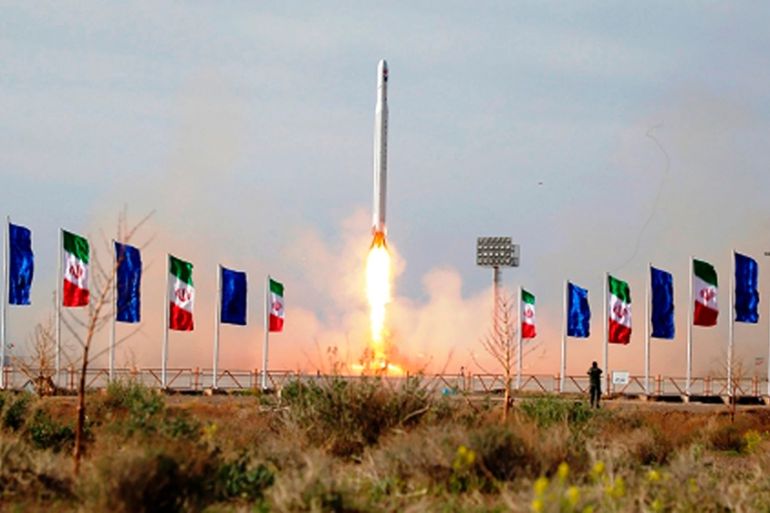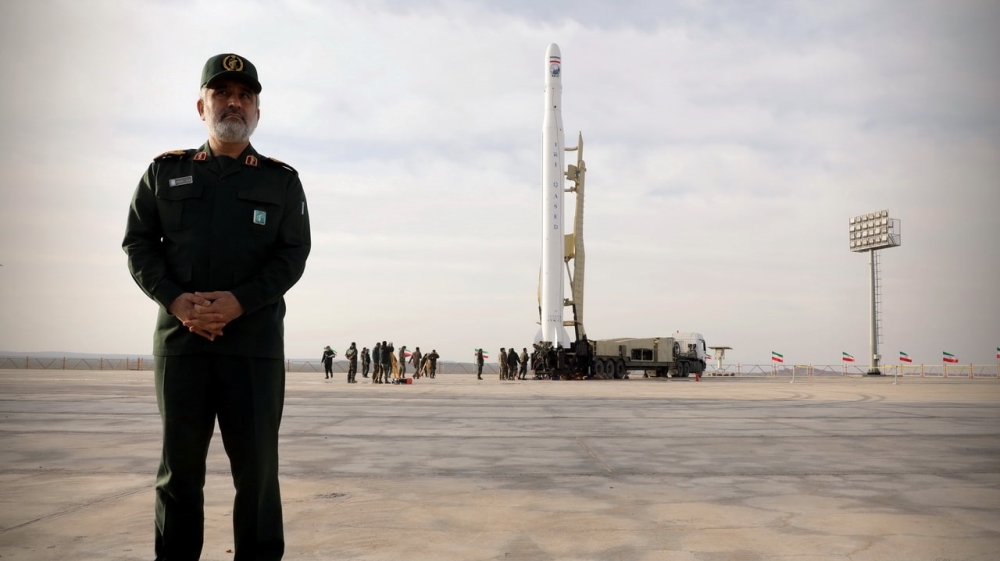The race to dominate space continues despite the coronavirus
Iran’s satellite launch is just the latest significant event in a string of military developments in space.

The coronavirus might be bringing entire sections of the global economy and society as we know it to a halt, but it has not slowed the militarisation of space.
“I’m not sure whether Russia, China and Iran are taking advantage of COVID-19, or not, to move forward with the testing and deployment of their ballistic missile and anti-satellite capabilities,” Frank Rose, a former United States assistant secretary of state for arms control and a senior fellow at the Brookings Institution, told Al Jazeera.
Keep reading
list of 4 itemsWhy is Biden ratcheting up the trade war with China?
Ivorian cocoa farmers ‘barely survive’ while chocolate company profits soar
Singapore Airlines death: Is climate change making air turbulence worse?
“However, one thing is very clear to me: these countries see ballistic missiles and anti-satellite weapons as central to their strategies to counter key US military advantages.”
At the beginning of March, the US Space Force announced it had acquired its first offensive weapons system, a satellite signal jammer called the Counter Communications System.
Two weeks later, China launched three classified military satellites into low Earth orbit (LEO), which the state-run news agency, Xinhua, said would operate as a group to test remote sensing technologies. Earlier this month, Russia tested a rocket designed for that nation’s anti-satellite (ASAT) missile system.
The latest event comes from Iran
The latest significant event occurred on Wednesday last week when Iran successfully launched what it described as a four-kilogramme (8.8-pound) “reconnaissance” satellite into orbit, provoking a blast of accusations about ballistic missile development from a handful of nations, and a sarcastic tweet from US Space Force Commander General Jay Raymond, who called Iran’s satellite “a tumbling webcam in space”.
While space is not a new domain of operations for the Russian, Chinese, American and other militaries, it is for Iran, sort of. For years, Iran has used spoofing – transmitting a signal that imitates the Global Positioning System (GPS) – and satellite-jamming technologies to target US ships and foreign broadcasters, according to the Center for Strategic and International Studies (CSIS).
While many have focused on the Nour-1 satellite launch itself, the fact that the Islamic Revolutionary Guard Corps (IRGC) was behind it has some experts saying the event has officially revealed what they have known for a while, that Iran has a “space force” of its own.

Since 2017, Iran’s space agency has racked up four failed attempts to launch a satellite, and a mysterious rocket explosion on the launchpad. There has been speculation that foreign sabotage may have caused any one or all of the failures and the blast and perhaps an unconnected fire at the Imam Khomeini Space Center in February 2019, which killed three people.
Kaitlyn Johnson, associate director of the Aerospace Security Project at CSIS, told Al Jazeera that, not only was Wednesday’s successful launch a surprise to her, but who was in charge of it was too.
“What could be the difference is that the string of failures was conducted by the Iranian Space Agency, from a very well known spaceport that we track and the US government has eyes on. But this successful launch was actually carried out by the military and from a different location as well,” Johnson said.
To conduct last week’s launch, the IRGC is thought to have taken the cube satellite and a three-stage Qased rocket some 330km (205 miles) outside of Tehran into the Central Desert to a mobile launch platform in Shahroud. North Korea uses similar launch platforms as they are more difficult for intelligence agencies and their imaging satellites to monitor.
Business as usual?
These provocative events have transpired while most of the planet has been focused on battling the coronavirus that causes COVID-19. Russia, China, Iran and the US have all been criticised for their handling of the pandemic.
The timing may feel like a coincidence, but Namrata Goswami, an independent analyst and author specialising in space policy, told Al Jazeera that the pandemic is not driving the schedule.
“This has been long in the making. The pandemic situation creates a window of strategic opportunity,” she said. But while “these space launches are usually scheduled in advance, it clearly showcases that both China and Russia’s actions are aimed at creating strategic vulnerability vis-a-vis the US”.
Goswami said she believes that, for Iran, the US assassination of the IRGC’s top commander, General Qassem Soleimani, in a drone strike in January, and the recent spate of the IRGC’s speedboats harassing US Navy warships in the Gulf comprise the calculus at work.
“The successful launch of the Nour satellite to low Earth orbit, a first by Iran on a new Qased rocket, is to showcase Iranian technological prowess in the context of that assassination that left Iran’s top leadership shaken and ashamed,” she said.
“These space launches, in general, are meant to demonstrate that leadership in the final frontier is contested.”